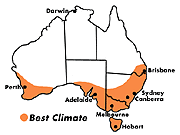Robinia Problems
Don looked at a street tree planting of golden robinias (Robinia pseudocacia ‘Frisia’). This was a vogue tree in Australian gardens and landscapes during the 1980s and it is still tremendously popular today. However, before you plant a golden robinia it is important to be aware that this tree is very prone to suckering. Robinias are grafted on to R. pseudoacacia rootstock (also known as false acacia or black locust), a vigorous green-leaved tree with thorns. Damage to roots, for example by mowing or whipper snippering, can lead to suckering. Stress to the tree which causes the top part to die can also lead to suckering (as shown in our segment).
What to do
Keep an eye on grafted plants such as golden robinia. Remove any suckers as they are noticed and keep the tree well watered and well mulched to avoid surface roots and root damage. Suckers should be removed with a clean sharp cut as close as possible to the root. Take care when mowing or gardening around any grafted plant, particularly robinias. Rather than growing grass under grafted trees, use a mulch. If the suckers come from a tree that has died they can be painted with the herbicide Roundup. If they are attached to a living tree the Roundup would possibly kill the tree as well. Suckers must be controlled, otherwise they will grow vigorously into large thorny specimens of the false acacia.
Plant details
Common name: Golden robinia
Botanic name: Robinia pseudocacia ‘Frisia’
Description: Hardy deciduous tree to 8-10m (24-30′). It has a rounded crown of clear yellow spring leaves, which darken slightly through summer, and then turn bright yellow again in autumn before they fall. The fragrant, creamy white pea-type flowers are followed by flattened pods containing kidney shaped seeds.
Best climate: Warm to cool areas (Brisbane to Perth and south, and mountain zones).
Uses: inner city street tree industrial landscaping polluted areas
Good points: hardy quick growing pollution tolerant golden autumn colour creamy white racemes of perfumed flowers
Downside: As mentioned above ‘Frisia’ does have one important drawback: it is prone to suckering. If your golden robinia is suckering you will know immediately, because the suckers will be green and thorny instead of yellow.
Getting started: Golden robinias (Robinia pseudocacia ‘Frisia’) are available at nurseries and garden centres. They cost about $25 for a 200mm (8″) pot.



